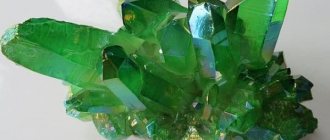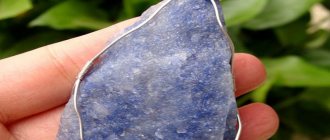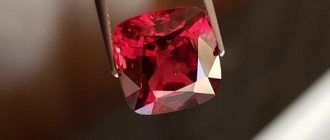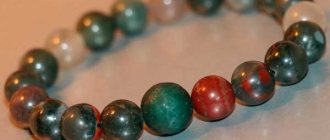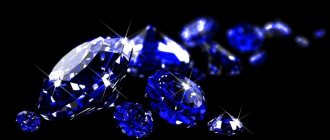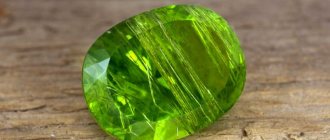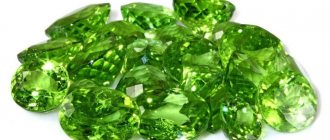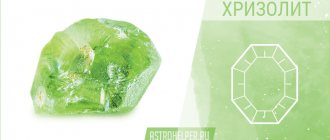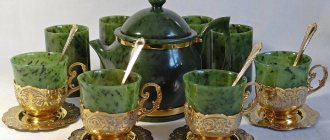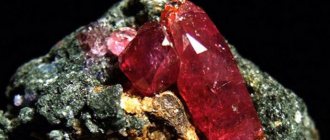Chrysolite is one of the oldest minerals known to mankind. The first mentions of it can be found in documents dating back to the 4th millennium BC. e. Translated from ancient Greek, the name of the mineral means “golden stone”. It also has other names: geologists more often use the name olivine, and jewelers use peridot. For its amazing property of acquiring a rich green color under artificial light, the gem became known as the “evening emerald.”
A stone that has such charm and attractive power could not help but be assigned magical properties. What mystical qualities of the peridot stone are mentioned most often and who might this stone be suitable for?
History and origin
Along with diamonds, mention of chrysolite is found in Christian chronicles and the Indian Vedas. A translucent green mineral with a golden olive tint was popular with the pharaohs of Ancient Greece and the Turkish sultans. Rulers used the gem to decorate clothes, thrones, and household items. The stones were inserted into rings that protected the owners from evil spirits. According to legend, Nero, looking through the mineral, saw the course of historical achievements. During the reign of Cleopatra, it was believed that a person who hid a crystal in his mouth became invisible. These superstitions fueled interest in olivine for 60 centuries.
Peridot has a golden olive hue.
The Crusaders brought chrysolite to Europe. Gems gained popularity among aristocrats due to their beauty, which was not lost even against the backdrop of diamonds. At dusk, in the light of candles, the mineral acquired a rich green color, which explains the other name of the stone - “evening emerald.”
To better market their products in the 19th century, French jewelers spread the rumor that olivine increases potency. A step-cut olive-green peridot weighing 193 carats adorns the Russian Crown, kept in the Diamond Fund.
Basic physical and optical characteristics of the stone:
- bottle glitter;
- transparency;
- uneven fracture.
The crystal dissolves in acids; foreign inclusions (spinel, mica, chromium) are rare. Despite the high density value of 3.2-4.3 g/cm³, the internal tension of the silicate leads to the splitting of the stone under aggressive influence. A peculiarity of peridot is the splitting of the image when looking at an object through the mineral.
By origin, chrysolite is a silicate of iron and magnesium.
The radiance of peridot depends on the admixture of nickel and chromium. The richness of the golden green color increases the value. Crystals are found in igneous rocks of mountain ranges - dunite, diabase, peridonite, tuff, basalt. The mineral is not found in silica-rich quartz veins. The gem is common in nature as a companion to diamond deposits. Olivine was found in lunar soil, as part of meteorites that fell to Earth.
Place of Birth
Particularly large crystals have been mined since ancient times on the Egyptian island of Zeberged, located in the center of the Red Sea. Smaller-scale basalt and kimberlite deposits of chrysolite have been developed in South Africa, in the south and southwest of Asia (Pakistan, Afghanistan), and on the Hindustan Peninsula. Placers of gems are found in Australia and the American state of Arizona.
In the Russian Federation, chrysolite in olivine basalts is mined in the south of Buryatia, in the Tokskoye deposit (Yakutia). High-quality jewelry olivine was found in the Ospinsky and Kharanursky Sayan massifs. Transparent stones from golden-green to marsh color lie in calcite nests west of the city of Kovdor in the Murmansk region.
There are known deposits in the north of the Krasnoyarsk Territory, on the Kola Peninsula.
Colors and varieties of peridot
The most common natural gemstone is pale green in color. But they find placers with intense shades of grass and olives. The pistachio, yellow, brown, and golden highlights of the mineral are valued. The difference in shades depends on the concentration of iron oxide in the stone. There are crystals with rare optical effects - cat's eye, star glow due to light diffusion (asterism), play of colors and highlights (opalescence), iridescent radiance (iridization). Officially, chrysolite is classified into golden-yellow minerals without brown impurities (grade A) and all other orthosilicates interspersed with other shades (grade B).
Is chrysolite a common mineral?
Chrysolite is a semi-precious stone that is widely used for making jewelry. Gold or silver earrings and rings with inserts made of this beautiful mineral with a mysterious greenish tint look very impressive. In addition, peridot, or peridot, is actively used to decorate interior items. Another area of application of the stone is icon embroidery.
Chrysolite as a mineral belongs to one of the valuable varieties of olivine. Among its features are fragility and susceptibility to high temperatures. At the same time, it dissolves well in acids and is easy to polish. Another characteristic feature of the mineral is its glassy luster.
Gold earrings SL with peridot, emeralds and diamonds (go to the SUNLIGHT catalogue)
The natural color of peridot is pale green with an admixture of golden, yellow, olive and brown shades. It is extremely rare to find brightly colored stones in nature. At the same time, the value of the mineral for jewelers depends on the saturation of its color: the brighter the shade, the more expensive the peridot will be.
Based on color, olivines are divided into 2 types:
- grade A - stones with a yellow-green tint without a brown tint;
- grade B - pale stones with noticeable inclusions of other colors.
Olivine contains iron-magnesium orthosilicate; it is the amount of iron that ultimately affects the color of the mineral. Sometimes nickel and chromium can be found in the composition of chrysolites.
The chrysolite ornamental stone is processed using step, diamond or emerald cutting methods with special care due to its fragility.
Deposits of these gems are located in Egypt, Pakistan, Burma, Mongolia, Mexico, Vietnam and some other countries. Chrysolites can also be found on the territory of the Russian Federation.
SOKOLOV gold ring with chrysolite and cubic zirconia (go to the SUNLIGHT catalogue)
Although olivine is not very expensive, it is nevertheless one of the rare minerals and quite often they try to counterfeit it. You can distinguish a fake by running a sharp object across the surface of the stone. Natural peridot will remain unharmed, but shavings will begin to peel off from the plastic fake. Another way to check the authenticity of olivine is to hold it in your palms for a while. The fake will quickly heat up, but the real stone will remain cool.
Medicinal properties
In lithotherapy, chrysolite is used for the following diseases and conditions:
- erectile disfunction;
- seasonal colds;
- arrhythmia, tachycardia;
- headaches, neuralgia, labor pains;
- high blood pressure;
- rehabilitation in the postoperative period;
- prostration;
- dermatitis;
- thyroid dysfunction;
- problems with the digestive system.
Contact of a healing crystal with the body during acute respiratory infections reduces elevated temperature. Chrysolite, crushed into powder, treats psoriasis and cleanses the body of decay products. Looking at the mineral every day for half an hour stops the development of myopia. If you wear jewelry with peridot constantly, stuttering in people with speech disorders is reduced, night sleep is normalized, and nightmares disappear.
Jewelry with olivine helps normalize sleep.
National treasure
The world's largest treasuries are proud of their precious green exhibits.
Chrysolite is revered in Russia. The country's diamond fund has two:
- Listed among the seven “historical stones” is the olive green crystal from Seberget. It is larger than a quail egg, weighs 192 carats, is superbly cut, and is of exceptional purity.
- Bow brooch and girandole earrings.
Light green stones complement the gold frame of the Trinity icon by Andrei Rublev.
Thanks to color, we are revered by the Muslim world:
- Rulers and rich people decorate their turbans with olivine;
- the collection of chrysolites from the fabulously rich treasury of the Ottoman Empire is the largest in the world;
- The throne of the Sultan in Istanbul is inlaid with thousands of stones.
The Vatican keeps Nero's monocle. According to Pliny, the emperor who set fire to Rome contemplated the fire and gladiatorial battles through it.
The Smithsonian Institution in the US capital owns the world's largest crystal at 310 carats.
Magical features of the chrysolite stone
The mineral attracts good luck and protects against evil spirits. The magical stone chrysolite helps the owner:
- avoid conflicts;
- attract good luck;
- build friendships and friendships;
- fight envy;
- forget past experiences, grievances;
- learn to have compassion for others;
- find peace of mind;
- make thoughtful decisions;
- avoid attacks from ill-wishers, accidents, thefts;
- increase sexual attractiveness;
- solve a difficult life problem.
The magical properties of chrysolite develop the owner’s intuition, which helps to better understand the interlocutor. Intellectual abilities increase, obstacles in achieving the goal are eliminated.
Peridot attracts good luck.
Talismans and amulets
Chrysolite as a talisman has powerful powers. An amulet in silver protects against injuries, wounds received during military operations, and fires. A talisman made of crystal set in gold protects the owner from magic spells, damage, and the evil eye.
An amulet with a green-yellow mineral is suitable:
- participating in legal proceedings;
- disappointed in friendship;
- people with chronic bad luck in love and career;
- moneylenders;
- financiers.
The talisman preserves the marriage union and encourages single people to make new acquaintances. The owner of olivine improves health, develops aesthetic taste, and enhances charm. Peridot increases self-esteem, which has a beneficial effect on business management. Uncut stones that know one owner are considered suitable amulets.
When the mineral is transferred to other hands, the magical powers of the amulet are lost.
Esotericists love magical talismans for establishing a connection between the material and spiritual world. It is used in rituals and for meditation. The amulet is useless for down-to-earth people who are only interested in the material side of life, since they are unable to perceive the subtle energy vibrations of the gem.
A talisman with a chrysolite stone protects against injury.
Who is suitable for chrysolite according to their zodiac sign?
The energetically strong mineral should not be worn by Scorpios, who become puppets in the hands of others, or by Aquarius and Cancer who are lazy at work and indifferent to others. Experts who compile horoscopes are confident that the chrysolite stone is suitable according to the sign of the Zodiac circle for those who control their own destiny.
Signs that the magic crystal favors:
- Pisces , solving vital issues, eliminating conflicts in the work team, family;
- Virgos, gaining confidence, reducing excessive demands on themselves and others;
- Lions, with the help of magical olivine, overcoming obstacles on the way to the achieved goal.
- Geminis better understand their desires and capabilities, find peace of mind, get rid of tossing and uncertainty;
- In complex Libra , self-esteem rises, phobias disappear, and the circle of acquaintances expands;
- Stubborn Taurus show generosity and make concessions;
- The yellow-green crystal makes tempered Aries
- In straightforward Sagittarius , harsh judgments are smoothed out and emotional stability is established;
- Capricorns avoid set traps and radiate confidence and sexuality.
The individual meanings of the stone for signs are united by one common property - attracting good luck.
Compatible with names and other stones
The name given to a person at birth clearly influences one’s destiny. To control the uncontrollable flow of energy, amulets in the form of jewelry with suitable stones are used. Gems help correct unattractive character traits. Those who are suitable for chrysolite fully experience the positive, clean energy of olivine and are revealed in their positive aspects:
- Dreamy Margarita finds a good life partner;
- Innocent's creative abilities are revealed, secrecy and isolation disappear;
- Evgeniy decides on a profession, realizes his dreams, achieves success in his career and prosperity;
- Alevtina’s explosive character becomes softer, communication with the female half of the team is established;
- Marina trusts people more, makes new acquaintances;
- Good Antonina learns to refuse intrusive petitioners;
- Oksana soberly evaluates her actions and does not blame others for their troubles.
Chrysolite is also suitable for Jacob, Seraphim, Laurus, and Demyan.
The power of peridot energy doubles when compatible with stones of the elements of Fire and Air. It is difficult for the mineral to get along with gems of the Water element and comes into conflict with earthly gems.
Compatibility table for stones with peridot:
| Full compatibility | Absolute incompatibility | Undesirable neighborhood |
| Sapphire | Onyx | Alexandrite |
| Coral | Lapis lazuli | Aquamarine |
| Cornelian | Jasper | Bloodstone |
| Ruby | Malachite | Pomegranate |
| Diamond | Agate | Opal |
| Amethyst | Obsidian | Moon rock |
| Pearl | Sardonyx | Emerald |
Olivine and coral are good compatibility.
If you do not take into account the combination of minerals, the stones will suppress each other, which will adversely affect the physical health and mood of the owner of the jewelry.
Present
In terms of price, chrysolite is inferior to precious stones, but it is no less valuable as a gift for a loved one. The Dragon Stone, full of inner nobility, will definitely bring happiness to the owner.
It is desirable that the shape of the talisman resembles an animal. This form is close in spirit to the solar energy of the stone and will give the greatest effect.
Chrysolite (Olivine) is worn without a frame or in gold; this noble metal significantly enhances the positive properties of the stone. The gem has very good energy regeneration, so even if the stone was once stolen, there is no need to worry that it may become a carrier of negative emotions. The only thing you can’t do is steal peridot yourself, then it will do nothing but harm.
How to spot a fake
Chrysolite is not synthesized in laboratory conditions; this is pointless, since natural crystals are affordable. But some scammers try to pass off bottle glass or plastic as olivine.
Methods for determining imitation gems:
- The thermal conductivity of the mineral is lower than that of plastic and glass. If you hold the crystal in your hand, the coolness of the natural crystal will last longer.
- Due to its high density, there are no marks left on the edges of peridot from the point of a pin or a piece of glass. If the olivine is genuine, it will leave marks on the glass and remove shavings from the plastic.
- Uneven coloring and transparency of the stone indicate its unnatural origin. The absence of haze and an even yellow-green color are signs of real peridot.
- Faceted chrysolite has the property of refraction of rays, which, passing through the structure, bifurcate the object in question. Imitations do not have such characteristics.
- The deposits rarely contain stones with a diameter greater than 1 cm. Large crystals require especially careful examination to determine authenticity.
- Before purchasing a mineral, they require a certificate of conformity.
- Artificial spinel, cubic zirconia and green chrysoprase painted with a solution of manganese are also passed off as peridot.
A fake is distinguished from real olivine by the absence of optical effects or by laboratory testing.
Gemini Star Talismans
Angelina Jolie's favorite stone, born on June 4, is emerald. The Hollywood actress has several pairs of luxurious earrings and a ring with it. It was in jewelry with emeralds that she especially shone on the red carpet.
Marilyn Monroe (June 1) often chose pearls as a talisman, wearing a string of pearls or earrings with pearls. Supermodel, actress and TV presenter Heidi Klum, who celebrates her birthday on June 1, often appears at social events wearing jewelry with agates, which allow the star to be successful in all endeavors.
Natalie Portman, another representative of the sign, loves to change her looks, shining now in sapphires, now in emeralds, now in agates.
Scope of application
More often, faceted chrysolite is inserted into rings, earrings, bracelets, and pendants made of gold or silver. Jewelry with small gems is sold in the form of beads and necklaces that do not require a frame. To reveal the magical properties, jewelry in the form of rings and bracelets are worn on the left hand without time limits.
Luxury items are encrusted with minerals with optical effects. Crystals are used for embroidering clothes and faces of saints. Olivine is used to decorate cups and tiaras. Stones unsuitable for jewelry making are used to carve figures and figurines that decorate the interior of homes.
Uncut natural chrysolites are used by magicians for rituals.
Cost of jewelry
The cost of a gem is influenced by size, color, cut, and uniformity of structure. Chrysolite is a semi-precious stone, so you don’t need a lot of wealth to purchase it. The average price of a mineral no heavier than three carats is $50–300. The cost of stones cut in the shape of a perfect circle is from $200 per carat. The cheapest minerals are pear-shaped.
The cost of peridot increases for stones:
- with a clean transparent structure, with the exception of cat's eye and asterism;
- rich green color;
- large sizes.
Peridots over 10 carats without foreign inclusions are rare, used in premium jewelry and cost several hundred dollars per carat.
Appearance of the stone
Externally, in the photo, the peridot is transparent or clouded. The color of the stone varies, but within the range of greenish-yellow shades. The golden shimmer is perhaps what distinguishes it from the minerals peridot and olivine. This feature is present in every type of chrysolite. There is no specific evaluation criterion for intensity. Magic chrysolite is distinguished by the fact that the full disclosure of the iridescence occurs under artificial lighting.
Caring for peridot products
A fragile gem in jewelry requires careful handling. It is unacceptable to store the mineral in a box with high-density stones. It is more practical to place the crystal in a canvas bag and place it in a place protected from sunlight. When exposed to bright light for a long time, peridot changes color to a lighter, more inexpressive color.
To avoid mechanical damage and keep the product clean, chrysolite is recommended:
- do not hit or drop other objects;
- dry naturally at room temperature or wipe with a soft cloth;
- clean with soapy water, after making sure that the stone is not attached to the frame with glue;
- in a silver frame, clean with baking soda, rinse with running water;
- When removing dirt, wash with a soft sponge, not a brush;
- dip in a solution of ammonia (5 mg per glass of water), after an hour, wash off the active substance;
- Do not clean with chemicals or abrasive materials.
Jewelry such as rings and bracelets with peridot are not suitable for everyday wear due to the high risk of damage from accidental impacts and environmental influences. When cleaning the apartment, decorations are removed to avoid clouding and loss of shine from contact with cleaning products. Products with peridot, with careful care and proper use, last a long time, bring good luck to the owner, reveal positive qualities, and strengthen families.
Chrysolite for healing ailments
The magical properties of the chrysolite stone are not limited to attracting good luck into the life of its owner. These green gems have a powerful healing gift. Lithotherapists (adherents of the practice of treating diseases with the help of stones) actively use peridots to combat many ailments.
The areas of application of the “evening emerald” in lithotherapy are truly diverse:
- Treatment of eye diseases - just look at the stone for a long time.
- Healing from cardiovascular and endocrine diseases.
- Relief of fever symptoms.
- Rescue from insomnia and nightmares;
- Getting rid of stuttering by constantly wearing jewelry with peridots.
- Acceleration of the recovery period after serious illnesses.
- Relieving pain, for example, during migraines, inflammation in the stomach, kidneys, liver, spine. In addition, it is believed that the stone helps women in labor endure contractions more easily.
Lithotherapists often use chrysolite powder to improve the overall health of the body and cleanse it of toxins. Based on this powder, adherents of alternative medicine prepare ointments for the treatment of skin diseases.
